Who is Dancing the Bhangra?
Anjali Gera Roy
Background
Traditionally, Bhangra looks back to a Punjabi harvest rite dating back to the time of Alexander’s invasion of India, that continues to be performed at the annual festivals of lohri and baisakhi. No Punjabi wedding is complete without a round of Bhangra, nor is any other celebration. But internationally, Bhangra is better known as British Asian dance music and it is as British as chicken tikka masala today!
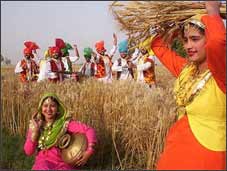
On the eve of Baisakhi
‘Modern’ Bhangra dates back to the 14th century but the generic term ‘Bhangra’ was apparently invented after the Partition of the Indian subcontinent in 1947 to refer to a variety of (gender, region, sect based) dance/music genres found in the doaba or the deltas of Punjab’s five rivers. Modern Bhangra is primarily based on the sialkoti style though it has amalgamated movements from other genres such as jhummar, malwai giddha, luddi, julli, dhamal, pathania, gatka and dankara as well. Bhangra, overall, is the old circle dance with dancers moving around the dholi or the drummer. The drummer punctuates his beating of the drum by lifting the two sticks to beckon the dancers to increase their speed. Beginning with a slow movement of their feet, the hands, the feet, and the entire body comes into play as the beat becomes faster. The dancers whirl round and round bending and straightening their bodies alternatively, hopping on one leg, raising their hands, waving their handkerchiefs and exclaiming Balle Balle! Oh Balle Balle!
Male Bhangra genres
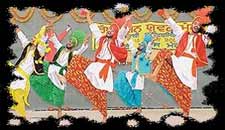
Bhangra
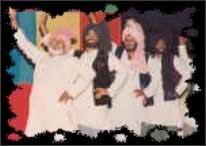
jhummar
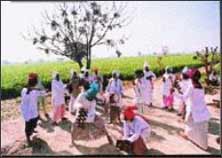
malwai or babian da giddha
Female Genres
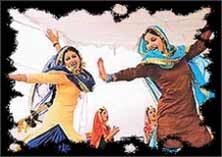
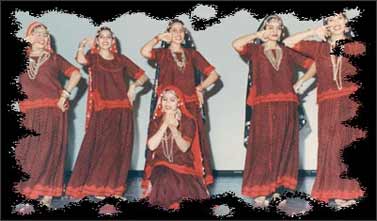
sammi
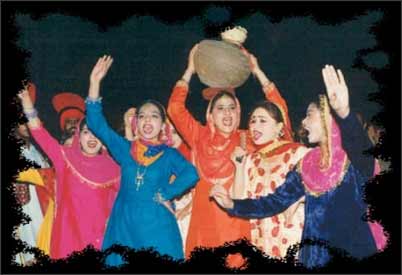
jaggo
British Bhangra has been hailed as the new Asian dance music marking British Asian presence on the popular cultural scene and Indian youth have also taken to it in a big way but the same kind of hybrid Bhangra genres, including the homegrown Bhangrapop or Punjabipop invented by Gurdas Mann and Daler Mehndi, have been met with skepticism in traditional India. Bhangra mutants are dismissed for disregarding several requirements of traditional Bhangra. They are seen to violate the rules of Bhangra performance by mixing movements and styles from ‘alien’ Western dance forms and failing to observe norms relating to what can be said, by whom and where. Purists consider their exposure of the female body to public gaze as among the gravest of offences. But beneath the allegations of ‘obscenity’ and ‘vulgarity’ one still detects genuine concern over the desacralization of the Punjabi harvest rite through its contamination by commercial interests.
New Bhangra mutants, both the desi hybrids of Gurdas Mann and Daler Mehndi and vilayeti hybrids of Bally Sagoo and Punjabi MC, have also invaded the nation’s popular cultural vocabulary challenging Bollywood’s hegemony in the Indian popular cultural space, as far as popular music goes. Bhangra music is no longer confined to Panjab or Punjabis but can be heard as far as Trivandrum where Daler Mehndi is reported to have sold a million copies. From the nightclubs of Delhi and Bangalore to the lanes of Mumbai and Goa, Indian youth of all classes, castes and regions may be seen dancing to these familiar beats. Bhangra’s popularity, in fact, made Bollywood capitulate to ‘low’ Punjabi tastes and make it is a part of many a song and dance sequence. In fact, Bhangra’s Bollywood turn nationalized it completely. Its performance at Bollywood wedding and ‘family gathering’ scenes made Indian groups, other than Punjabis, incorporate it in their traditional celebratory rites.
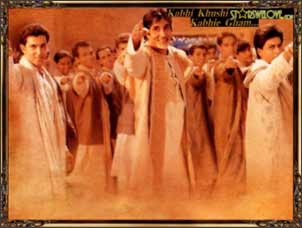
Hrithik Roshan, Amitabh Bachchan and Shah Rukh Khan performing Shava Shava in Kabhi Khushi Kabhi Gham
The space cleared by Bhangra mutants in the Indian popular cultural space has also made room for other Punjabi genres such as jugni and heer and also other folk traditions such as Rajasthani and Gujarati. The new youth icon is a young Sikh called Rabbi Shergill who has set a twelfth century sufi poet Bulle Shah’s verses to music. Thus, Bhangra’s popularity appears to have ushered a regional and folk music revival on the Indian subcontinent. Folk is not decried as rustic but has become part of the new ‘cool’ that embraces a wide sonic range from rap to techno. Rustic Punjabi artists now enjoy a large following among urban youth, even from the Westernized segment, to a limited extent. The Punjabi harvest rite’s entrance into the popular cultural space has brought it unimaginable visibility and popularity. But Bhangra is so deeply immersed in the field of commerce that it cannot function outside the market.
Commencing the journey
Who is dancing to Bhangra, when, where, and with whom? What is this strange music anyway? How can big men and women shout and jump when bigger sardars with thin voices croon on the screen or floor? To find out what accounts for the Bhangra magic, I traveled across Bhangra sites from Bengal to Bangalore and discovered that Bhangra fever rages.
My journey into the roots of Bhangra began at home in Kharagpur. In true Bhangra tradition it was a ‘return to roots’ voyage for me as well from Kharagpur in Bengal to a virtual Punjabi homeland. I discovered Bhangra on American owned MTV courtesy a pony-tailed sardar from Kenya in glares who ‘returned’ to me the songs and dance of my childhood. Balle Balle te tor panjaban di he sang transporting me back to Punjabi Lucknow where the Partition displaced Punjabi diaspora created ‘a sense of place’ by singing and dancing to balle balle at all celebrations. Ready to embark on the return to roots journey, I signed in for the local Punjabi society in Kharagpur, which I had managed to elude as a deracinated Punjabi so far. My informants predictably came from the members of the same society but wouldn’t let out their secrets until I turned participant.
On 13th January and 13th April every year, the sardar-owned-open-air restaurant Sahara screens off a generous space for the celebration of lohri and baisakhi, the covered space serving as the DJ console and buffet and the open area as the dance floor. Chairs are arranged in a circular fashion around a huge pile of logs and a screen conceals the revelers from the rest of the diners.
 High speed PCs with high-powered speakers are smuggled from hostels hours earlier to get the music ready. Jaspreet Narang, a diminutive sardar from UK with blonde beard is the self-appointed DJ because he is reputed to have the large collection of Punjabi music. As the evening wears on, the fire is lit; hostel gangs trickle in and settle in the student area of the circle. Faculty, staff and their wives occupy the opposite end, Punjabi matrons stoutly guarding teenaged daughters while men affect dignified academic postures. All eyes are seeking the girls, the rarest species in IITs. The half a dozen girls, when they arrive, are unrecognizable in Punjabi finery. All stand around the fire as ritual prayers and libations are offered to lohri. Gals and guys help matrons pass around trays of the lohri prasad of phulle, moongphali and revadi as revelers return to their places. The compere, Harsachin, calls out the first boli inviting one and all to respond: lathe di chaadar/ ute saleti rang mayia.
High speed PCs with high-powered speakers are smuggled from hostels hours earlier to get the music ready. Jaspreet Narang, a diminutive sardar from UK with blonde beard is the self-appointed DJ because he is reputed to have the large collection of Punjabi music. As the evening wears on, the fire is lit; hostel gangs trickle in and settle in the student area of the circle. Faculty, staff and their wives occupy the opposite end, Punjabi matrons stoutly guarding teenaged daughters while men affect dignified academic postures. All eyes are seeking the girls, the rarest species in IITs. The half a dozen girls, when they arrive, are unrecognizable in Punjabi finery. All stand around the fire as ritual prayers and libations are offered to lohri. Gals and guys help matrons pass around trays of the lohri prasad of phulle, moongphali and revadi as revelers return to their places. The compere, Harsachin, calls out the first boli inviting one and all to respond: lathe di chaadar/ ute saleti rang mayia.This year it is an intrepid male, an ex-colonel turned security officer, who responds with teri maan ne chadiyan sevian/asi mangiyan te pidan pai gayian.(Your mother cooked sevian/ When I asked for some she had a heart failure). Colonel is, however, trespassing on feminine territory. It is the women who take over from him clapping and chanting a litany of complaints against the entire clan of the husband except the favoured devar. Girls join in sportingly in the singing as a preparation for the familiar rite de passage.
The rest participate with ‘the Punjabi clap’ but I can sense them squirming in their chairs throwing impatient glances at Jassi. All Jassi needs is a signal from Mrs Singh to roll out the Bhangra! As he plays the warm-up song and the compere urges the group to come on, only a few dare to move forward and perform some perfunctory, self-conscious motions. With each successive number, more and more boys enter the circle of dancers. The others must be propelled by entry of the half-dozen girls who had been standing demurely so far. Initially confined to their separate circle, they permit a few friends to break into their exclusive circle. Before long, they are ready for a kinesthetic duel. Shubhroj, the strapping computer scientist who rarely needs an invitation, is in his element by now.
Divjyot, the plump and pretty chemical engineer, challenges him and meets him step for step, even in the male ankle lock until he whirls her round and round in a kikli. This year a bold medical postgraduate demands that ‘madams’ observing from the wings should also join in the dancing.

Madaman noon bulao
Mrs Sharma consents on the condition that the DJ play Punjabi MC’s mundiyan ton bach ke raheen. Swaying and gyrating to the fast chartbuster despite her enormous girth, Mrs Sharma is a Bhangra natural. Other ‘madams’ do not let their similar girth come in the way of pleasure of dancing the giddha. Their men, who had furtively slipped out return in high spirits courtesy the forbidden drinks served by the owner Nikku, and are now game to throw professorial caution to the winds and do some quick, high jigs.
This is the moment that Jassi chooses to preview his cousin Rishi Rich’s unreleased main te tere naal nachna. Against my will, I find myself being pulled by Divjyot and threatened with a ‘D’ grade unless I agree to mirror her movements. By the time I recover my breath from the kikli, the boys demand to be let in the female circle. I consent to dance with the diminutive Jassi because he has shared his entire collection of Punjabi music pirated, downloaded and shared with cousins across the globe with me. The buffet is announced but most leave reluctantly even after the conclusive railgaddi aayi. Shubhroz and Divjyot are the last to hold on, Shubhroz’s shirt clinging to his back and hair plastered and Divjyot’s silk suit soaked. The party is not yet over.
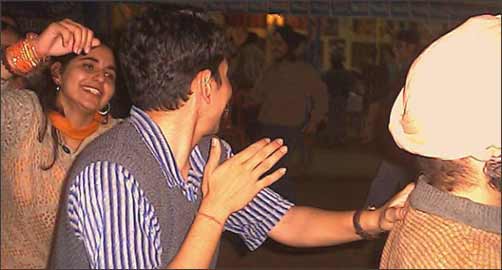 As guests ready to leave after dinner volunteers arrive demanding lohri singing sundar mundriye. I get away with only a hundred and promising five times the amount the following lohri.
As guests ready to leave after dinner volunteers arrive demanding lohri singing sundar mundriye. I get away with only a hundred and promising five times the amount the following lohri.Later, I reflect upon the evening in the light of everything I have read about Bhangra performance. The participants today have been Punjabi mainly and Bhangra, despite its consumption by non-Punjabis appears to play the role of cementing Punjabi blood far away from ‘home’. The participants did not all dance the Bhangra in a specific Punjabi way but regardless of how they were dancing it, it appeared to signify Punjab to all of them and therefore brought them closer, invoking a home that few of them may even be attached to, physically. Bhangra’s descent into the profane popular culture space may have desacralized the Punjabi harvest dance by removing it from its communal, participatory context into a culture of global consumption but it is this hybrid that perhaps signified ‘Punjab’ to those in far away Kharagpur. If Bhangra only betokens consumption, could its consumption itself not produce meaning for migrating Punjabis with different cultural trajectories and does this not salvage Bhangra from the logic of pure commerce?
In Bangalore Bally Sagoo has flown in from Birmingham to ring in the New Year. I can’t believe my luck. To meet the most popular Asian DJ who single-handedly ushered the Bhangra revolution in UK and got the gore and kale dancing to Bhangra in addition to Bengalis and Gujaratis in person. How would info-cosmopolitans in namma Bangalore respond to the new global beat? Bally turns out to be warm and friendly like my cousins from Chandigarh slipping in ludhianvi Punjabi into his unmistakable Birmingham English and tells me what a DJ is. My education begins when I watch him in action in the evening. The Punjabi munda from Birmhingham transforms into a star as he changes into a shiny T-Shirt and creates pure magic through sheer technology on the console. Punjabi poses no barrier to Bangalore mini-skirted and blue-jeaned teens as they simulate Punjabi dance steps in the banquet hall of Taj Residency to gud nalon ishq mitha. K3 G is still fresh in the memory to forget to make the bangles tinkle to the beat of lai ja lai ja. When Bally attempts a new mix of Shava Shava, even uncleji and auntieji descend on the jam-packed floor egging on toddlers and infants. On this occasion, mesmerized by Bally the star and a neo-ethnographer, I forgot to check what language the teenagers spoke at home and where was their ‘native place’. But the visual image they projected was that of the hip metropolitan youth who had been chosen to be present on the big evening.
On the following field trips, I was suitably armed with questions and recorder. The friendly manager of Zero B not only invited me to the Bhangra Night on Thursday but even personally escorted me to the tables where guests were nursing their drinks. I gingerly made my way towards the first table and found the perfect respondent in an under-eighteen on her first night out. She happily answered my questions and swore she loved Bhangra. The couples at the next table were cooperative enough but were too busy catching up with their friend from overseas to bother to fill in my rather long questionnaire. I agreed to move on to the next table with two young males.
The first, a Gujarati, tells me that he likes to dance to Bhangra and the second, a New Delhi Tamilian, informs me that after Daler he has stopped following Bhangra charts. At the next table, an official party with an overseas client is on but they sportingly agree to answer my questions in-between sips. I choose to speak to a young man who is delegated to pass on informed opinion on music. The young techie turns out to be extremely well informed on Bhangra music. The surprise is his middle aged Tamilian boss who confesses to a Bhangra weakness. My next targets are a software team on a sale party. They turn out to be former IITians from Bengal. With typical Bengali contempt for lowbrow Punjabi music, one claims he has never heard Bhangra. The other, on the other hand, waxes eloquent on the vocal range of Daler versus Mann. The boss, who has been listening quietly all through, owns up that he loves the Bhangra but preferably in the state in which he is at the moment. I spot a family group being seated in a reserved table and thrust my questionnaire under their noses. The women in the family from Bengal admit that they have heard some Bhangra but only through Bollywood. Their host is a young IT professional who answers on their behalf and his own. I couldn’t have been lucky the 13th time. I force my way into an all women software techies on a night out. They stolidly refuse to reply to even the most neutral question for they fear that their views will be published in The Times of India the following day. Their sole male escort requests me to direct all his questions to him. So I lose my chance to hear what good local girls think of Bhangra. The goris table is not any more inviting though the only one who speaks English tells me that she is familiar with Bhangra. Disappointed by the lukewarm responses to my survey of Bhangra’s popularity in the info capital, I am about to leave to keep to my own self imposed ceiling of midnight when the DJ plays the dhol beat. The goris are on their feet and jump across the enclosure to do energetic renderings of Bhangra. The rest finish their meal before flowing on to the rooftop dance floor. Within an hour the self-acknowledged Bhangra haters, may be Bhangra dancers and confirmed Bhangra dancers are jostling for space on the floor. I walk up to a gora consultant shaking his shoulders and an airhostess letting her hair down to ask what they think of Bhangra. On the indoor dance floor, Bangalore’s netizens are bringing the roof down by repeating the loops aaye haye, oye hoye in Malkit Singh’s gud nalon ishq mitha. It appears that music videos and Bollywood have coached all ethnicities to do the shoulder shakes and hand gestures class, caste, colour, age no bar. The cool dude who had denied interest in Bhangra escorts his girlfriend in sheepishly and can’t resist when she invites him to aaja mere naal nach lai (Come dance with me). I decide to call it a day when Daler Mehndi booms bolo tara rara and the entire lounge bar begins to resound with the shouts and jumps of the dancers. It is 11.30 p.m. The party has just begun.
The Bangalore experience seems very different from the Kharagpur one and the reason is perhaps that the crowd is more inclusive. While in Kharagpur Bhangra meant ‘home’ to a predominantly Punjabi crowd, in Bangalore it means something else, by and large. What does the Bhangra mean – especially its frequently absurd lyrics – to a Tamil speaking IT professional who has no acquaintance with the Punjab? When a Punjabi girl dances the Bhangra with someone not from the Punjab, does the dance mean the same thing to each of them?
Does the harvest rite lose out to the hybrid? Does its centrality to youth communities disengage Bhangra from its original ‘folk’ meaning? All evidence points to new meanings being made and the dividing line between ‘participant’ and ‘consumer’ becoming thinner every day. Purists may rage at the promiscuous mixing of genders, genres and languages. Punjabis and non-Punjabis of all ages, genders, classes, castes and professions continue to dance the Bhangra at every opportunity and it ‘connects’ deeply. Bhangra of all varieties, pure, hybrid, traditional, modern, live, recorded, is now played at Punjabi and non-Punjabi gatherings. Rural Bhangra professionals can be playing along side anglicized DJs at the same family event. Punjabi matrons would as easily join the rustic dancers and musicians in singing a traditional boli as waddling across to the improvised dance floor to dance to Punjabi MC’s mundian ton bach ke raheen. Bhangra moves at these occasions range from the ‘purest’ gatka or ‘snake dance’ to imitations of salsa and macarena. “Who cares where Bhangra is from and mixed with what foreign elements?” most people seem to ask. “What matters is the performance of the rite!” they affirm and they all understand it regardless of where their ‘homes’ are located. Bhangra, of even the hybrid kind, is the spontaneous expression of joy to mark an auspicious occasion but the joy itself may have little to do with a harvest on one of Indus’ tributaries!
Anjali Gera Roy is Professor in the Department of Humanities and Social Sciences Indian Institute of Technology Kharagpur. She is the author of Three Great African Novelists (Delhi: 2001) and Wole Soyinka: An Anthology of Recent Criticism (Delhi: 2006) and has published a number of essays on literature, culture and theory in reputed journals and anthologies.
The author gives an account of a personal journey through hybrid Bhangra today but the essay also raises questions about ‘purity’ in a folk form. What is the virtue of purity worth if the circumstances engendering the original form cannot be recollected? Should a form be preserved in its pristine state if it means consigning it to a cultural museum? What is the meaning of a Punjabi ‘harvest’ ritual other than the one it acquires through popular enactment, even if this is in Kerala? Can a harvest by the Jhelum or the Sutlej be pertinent to a Gujarati businessman dancing the Bhangra in Bangalore? It is interesting to read this travelogue in conjunction with the other two essays on multiculturalism and cultural hybridity.
Editor